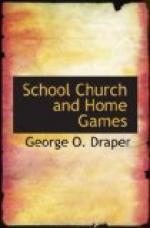Seeing the Old Home Town
Down the line next to the baseball diamond came the bowling alley, where everyone who was not a fan or a golf fiend was taking a hand at the sport. This alley was laid on a long board table, and the game played with tenpins and small wooden balls. Six balls for a nickel they sold here, and because the sport needed something to speed it up a bit they linked it with the food table next door. The best cooks in town presided over this. You paid your money for your tenpin balls, and proceeded to run up a score by counting the numbers on the pins you knocked down; the pins were set far apart to make it difficult. Then you took your score to the food table, where certain numbers of points brought you a glass of jelly, a can of mince-meat, a box of cookies, or a jar of mayonnaise. That bowling alley certainly did appeal to the women!
And if there was ever a more successful grab bag for the children than the quoits game, the Ashton Welfare Committee wants to hear about it. They called it a Good Luck booth for it had a horseshoe-shaped opening with a row of numbered pegs across the back. The kiddies bought the quoits, little wooden horseshoes cut from cigar-box wood, and tossed them over a peg. The number of the peg corresponded to a numbered tag which was handed out to be redeemed at the parcel-post window near the aerial mail plane.
This aviator, by the way, was an official of the Cupid Airline, so he advertised on his aeroplane, which was painted on a large curtain with a hole cut out where the seat would be, and the wheel of an electric fan poked through at the front and set going for a propeller. His mail bag hung over the side of the car inside of which he stood in aviation uniform, and for ten cents you could get your fortune in a small white envelope out of the mail bag if you were a man, or in a pink envelope if you were a girl.
But say, for a real scream, you had to take a sight-seeing trip in the auto! It was worth twice the toll. Dottie Earle had charge of it, and she made one of the funniest guides you ever heard. “This way, ladies and gentlemen,” she would shout through her megaphone; “get your tickets for a tour of the city in the most magnificently equipped sight-seeing autos that ever ran on three wheels and one cylinder! Only twenty-five cents, two bits a ride! See the birthplace of Ashton’s mayor, the history of Ashton’s past, its chief industries,” and so on.
When her tourists assembled in front of her machine, which was a real car, at least the front half of one, an old relic which the garage had just about decided to scrap, its latter half hidden behind a dark curtain, Dottie led them back of the curtain where the sights of Ashton were hidden. In another black curtain were a series of holes not any larger than a quarter, and behind each was one of the sights, a cradle, a picture of the town dump, a scrubbing brush and a large pen-knife for the sights already mentioned. For the Home Team she had a snapshot of the Warren twins, for the competitor of the Herald, a telephone, and so on with eight other “hits” on town topics and characters. So many guffaws and squeals of laughter came from behind the curtain that they had to call in a “traffic cop” to keep the crowd outside quiet.




